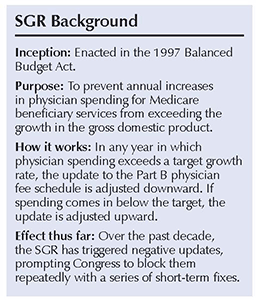Physician payments under the Part B Medicare fee schedule are due for a 24.4 percent reduction under the sustainable growth rate (SGR) formula starting Jan. 1, 2014, according to a preliminary estimate that the Centers for Medicare and Medicaid Services (CMS) sent to the Medicare Payment Advisory Commission (MedPAC).
This compares with the 26.5 percent cut that was to have taken effect at the first of this year until Congress stepped in to block it and froze physician fees through Dec. 31, 2013, under the American Taxpayer Relief Act of 2012.
The latest projection from CMS leaves the conversion factor at $34 through this year, said Jonathan Blum, CMS’s acting principal deputy administrator, in the letter to MedPAC Chairman Glenn M. Hackbarth. Next year, however, the factor is estimated to fall to $25.70. The conversion factor is used to translate the relative value units of a physician’s service (work, practice expense, and malpractice expense) into a dollar amount.
“Physicians are already facing an enormous gap between what Medicare pays and the actual cost of caring for seniors,” said American Medical Association President Jeremy Lazarus. “A two percent cut from sequestration makes this even worse, and a cut of 24.4 percent is simply unfathomable.”
Earlier this year, the Congressional Budget Office (CBO) pegged the 2014 fee cut at about 25 percent. It also lowered the cost of freezing Medicare physician payments from $245 billion over 10 years to $138 billion because of lower-than-expected growth in Medicare costs. This has encouraged hopes that Congress may find it easier to repeal the SGR since the question of how to pay for it has remained a major obstacle to an overhaul of the Medicare physician payment system. Hackbarth has said the time is ripe for reform because costs could rise again, prompting CBO to hike the amount it would take for a program overhaul.
Blum said in the letter that CMS would continue to refine its estimate of the SGR cut and will provide more information on the conversion factor in the proposed 2014 physician fee schedule due for release this summer.
Scrapping the SGR for a New Reimbursement System
Meanwhile on Capitol Hill, the House Energy and Commerce and Ways and Means committees, which share jurisdiction over Medicare, released on April 3 a second draft of their proposal to replace the current physician reimbursement system with a new permanent payment model and have requested feedback by April 15.
The second draft furnishes further details on their initial proposal issued Feb. 7 and incorporates comments from stakeholder groups. But the latest version focuses on policy, leaving the issue of how to pay for the change until later.
The key refinements in the transition include:
- »Phase 1: Repeal of the SGR followed by a period of stable payments (the time span is not specified, but physician groups favor having it last for five years).
- »Phase 2: Payments based on the quality of care delivered to beneficiaries, using physician-devised performance measures. Payments would be risk-adjusted so as not to penalize those who serve beneficiaries who are sicker or require complex care. Physicians would have three ways to determine their performance-based payment rate: their scores on quality measures compared with their peers’, major improvements in quality scores from the previous year, and clinical improvement activities. Doctors could opt to be measured at the individual or group practice level.
- »Phase 3: Financial rewards for providing efficient care, using a risk-based ranking system that also accounts for geographic differences in practice costs.
Throughout all three phases, physicians would be allowed to remain in fee-for-service Medicare or choose an alternative payment model.
“Designing a system that is inclusive of all specialties and practice types presents a great challenge, and this draft makes a concerted effort to avoid a ‘one-size fits all’ approach in favor of a versatile and inclusive process that provides for the maximum amount of individual choice,” the committees said. “Based on respondent input, we envision a system where providers have the flexibility to participate in the payment and delivery system model that best fits their practice.”
Legislators are aiming to have legislation that permanently fixes the Medicare physician payment system on the House floor this summer. It is not yet clear whether this would be a stand-alone bill or be part of a deficit-reduction deal between the White House and Congress.
Physician groups have generally responded favorably to the work of the two committees and have said that specialty-specific registries could be used to determine evidence-based quality measures. They also have called for timely feedback on these measures so doctors can improve and take full advantage of incentive payments.
They have further sought to include medical liability reform and to repeal the Independent Payment Advisory Board. That body, created by the health care reform law, would issue proposals to reduce Medicare spending if it breaches a specific target and these would take effect unless Congress comes up with an alternative that achieves the same amount of savings. The continuing resolution that funds government agencies through Sept. 30 provides no funding to make the board operational.
But the rub is likely to come when legislative language is presented that would define how the new reimbursement system would work. Some groups may take issue with what that language entails.
